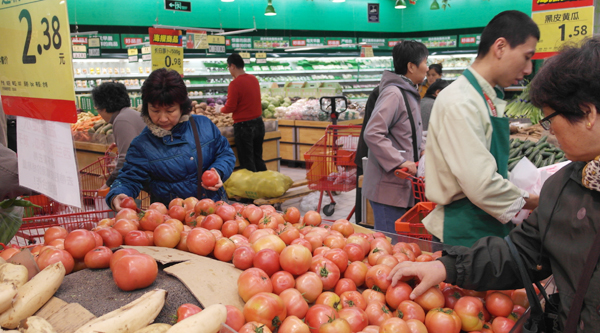A competitive edge is key

Kim Bong-han, director at Amicell Cosmetics, explained why the company participated in the Korean products exhibition at Jinan, Shandong Province in China last weekend. The Daejeon-based company’s Midas brand is mostly supplied to beauty salons and shops in Korea, but it is now eyeing an expansion to the Chinese market. The free trade agreement between Korea and China inspired the move. “If the FTA is signed this year, as Chinese President Xi Jinping said, the barriers between the two markets would disappear. The company has been researching the Chinese market for two years, when the FTA deal started to be mentioned.”
Many of the 300 companies in the exhibition are knocking on the Chinese market for the first time. And the free trade agreement is urging small domestic market-focused businesses to try out the export market. The exhibition halls, spread out on two floors, reminded me of the meaning of integration. The walls of tariffs and other regulations are crumbling, and the Korean and Chinese markets are gradually becoming one.
The trend is also evident in manufacturing. Kotra’s chief representative to China Hong Chang-pyo said that the cooperation paradigm in the manufacturing sector is shifting from the “division of work” to “integration.” In the past, parts were made in Korea and the final product was assembled in China. But technological advancement in China has allowed most parts to be manufactured in China as well. The divided production processes are not consolidated in China, leaving little need for Korean exporters to operate production lines at home.
Hong proposes multidimensional marketing on Chinese companies. Recently, four small and medium sized Korean companies visited Haier in Qingdao and gave a presentation to the appliance giant.
It was a customized marketing to supply parts to Haier. The fate of the integration paradigm in the manufacturing sector depends on whether Korean companies can expand supplies to Chinese companies. The answer is a multidimensional supply chain.
But if a product or service lacks a competitive edge, a bigger market and diversified supply chain would be meaningless. As the markets merge, companies that are falling behind may even lose the existing market to Chinese competitors. The companies with outdated technology would become marginalized. The integration paradigm is an opportunity and crisis at the same time. How should we respond? That is the question for Korean companies as the free trade agreement materializes.
JoongAng Ilbo, July 14, Page 34
*The author is the director of the China Institute of the JoongAng Ilbo.
BY HAN WOO-DUK
"당연한 거 아닌가요? 중국 시장이 우리 내수 시장 된다고 하잖아요." 지난 주말 중국 산둥(山東)성 지난(濟南)에서 열린 '한국상품전'에서 만난 아미셀화장품의 김봉한 부장은 전시회 참가 이유를 묻는 질문에 이렇게 답한다. '마이다스' 브랜드를 갖고 있는 아미셀은 본사를 대전에 두고 있는 화장품 전문업체. 주로 국내 미용실이나 전문 매장에 제품을 공급해 왔지만, 중국 시장을 뚫기 위해 전시회에 나왔단다. FTA가 계기였다. 그는 "시진핑(習近平)주석의 말대로 올해 FTA가 체결되면 시장 장벽이 사라지는 것 아니냐"며 "양국 간 FTA가 모습을 드러낸 2년여 전부터 중국 시장을 연구해왔다"고 말했다. 전시회에 참가한 300여 개의 회사 중에는 아미셀처럼 중국 시장을 처음 노크하는 업체가 많았다. 손 보습 팩, 뻥튀기 기계, 두유, 의료용 의자…. 심지어 충남 안면도의 한 업체는 고추가루를 들고 나오기도 했다. FTA가 작은 내수 기업을 수출 전선으로 끌어내고 있다. 1,2층 전시장을 오르내리며 든 생각은 '통합'이었다. 이제까지 관세와 각종 비(非)관세 장벽으로 울타리가 쳐졌던 한국과 중국의 시장이 서서히 하나가 되어가고 있음을 실감할 수 있었다. 전시회장은 그 통합의 흐름에 합류하려는 회사로 가득찼다. 제조업 분야에서도 통합의 흐름은 뚜렷하다. 전시회에서 만난 홍창표 kotra중국산업단 단장은 "제조업 분야 협력 패러다임이 기존 '분업'에서 '통합'으로 바뀌고 있다"고 말한다. 이제까지는 한국에서 부품을 만들고, 중국에서 조립하는 식이이었다. 그러나 중국의 기술 수준이 높아지면서 왠만한 부품은 모두 중국에서 생산된다. 국가 별로 흩어졌던 생산이 중국으로 통합되면서 국내 수출 기업은 점점 설 땅이 줄어들고 있다. 홍 단장은 대응 방안으로 '중국 기업을 대상으로 한 전방위 마케팅'을 제시한다. 최근 이뤄진 '하이얼 프리젠테이션'은 그 사례다. 한국의 중소기업 4개가 유명 가전업체인 칭다오의 하이얼(海爾)을 찾아가 프리젠테이션을 했다. 하이얼에 부품을 공급하기 위한 '맞춤식 마케팅'이었다. 반응이 좋아 곧 계약이 이뤄질 것이라는 게 행사를 주관한 kotra칭다오(靑島)무역관의 설명이다. 한국 투자기업뿐만 아니라 전체 중국 기업으로 공급선을 확대할 수 있느냐에 제조업 분야 통합 패러다임의 비즈니스 성패가 달렸다는 얘기다. 답은 역시 '다층적 서플라이 체인(공급사슬)'이다. 그러나 제품(서비스)경쟁력이 없다면 넓어진 시장, 공급선 다변화는 그림의 떡일 뿐이다. 시장이 통합되면서 내가 갖고 있던 시장마저 중국 기업에 빼앗길 수 있다. 기술력에서 밀린다면 영원히 주변부에서 맴돌아야 하는 외토리 신세로 전락할 수도 있다. 그러기에 통합 패러다임은 기회이자 위기다. '그 흐름에 어떻게 대응할 것인가?' 가시화되고 있는 한·중 FTA가 우리 기업에게 던진 숙제다. 한우덕 중국연구소 소장










with the Korea JoongAng Daily
To write comments, please log in to one of the accounts.
Standards Board Policy (0/250자)